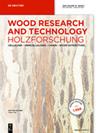Manilkara sp.的木材和木炭解剖比较:对市场检查的贡献
IF 1.6
3区 农林科学
Q2 FORESTRY
引用次数: 0
摘要
对木材和木炭进行解剖描述可用于多种目的,是编制数据库以正确识别物种的重要工具。本研究描述并比较了在巴西帕拉州一个保护区采集的 Manilkara sp.木材的定性解剖特征在文献中得到了证实,如弥漫孔隙;血管呈放射状多条;血管间的凹坑交替出现;轴向实质层呈线状或网状;射线单列或双列,不具纹理。此外,这项工作还报告了 Manilkara 的血管元素中存在螺旋状增厚,纤维中也可能存在螺旋状增厚。碳化过程后,解剖元素的形态发生了变化,血管频率增加了 23 % 到 141 %,射线频率增加了 2.8 % 到 12.9 %;射线高度降低,射线宽度增加。总之,一些解剖结构的变化可能与物种的可塑性、遗传学、年龄和环境因素有关,也可能是这些因素相互作用的结果。这些特征有助于对样本进行属级鉴定,木材和木炭的解剖学描述也有助于森林检查。本文章由计算机程序翻译,如有差异,请以英文原文为准。
Comparative wood and charcoal anatomy of Manilkara sp.: contribution for market inspections
The anatomical description of wood and charcoal for a wide variety of purposes is an essential tool for compiling databases to correctly identify species. This study describes and compares the anatomy of the wood and charcoal of Manilkara sp., collected in a protected area in the Pará state, Brazil. The qualitative anatomical characteristics of the wood, such as diffuse-porosity; vessels in radial multiples; alternate intervessel pits; axial parenchyma in lines or reticulate; rays uniseriate or biseriate, not storied, are corroborated in the literature. Moreover, this work reports the presence of helical thickenings in the vessel elements and possible helical thickenings in fibres in Manilkara . After the carbonization process, there were morphometric changes in the anatomical elements, as an increase in vessel frequency between 23 % and 141 %, and in ray frequency between 2.8 % and 12.9 %; while ray height decreased and ray width increased. Overall, some anatomical variations could be related to, or a result of the interaction between species plasticity, genetics, age and environmental factors. These characteristics enabled the identification of the samples at the genus level and the anatomical description of the wood and charcoal can be useful for forest inspections.
求助全文
通过发布文献求助,成功后即可免费获取论文全文。
去求助
来源期刊

Holzforschung
工程技术-材料科学:纸与木材
CiteScore
4.60
自引率
4.20%
发文量
83
审稿时长
3.3 months
期刊介绍:
Holzforschung is an international scholarly journal that publishes cutting-edge research on the biology, chemistry, physics and technology of wood and wood components. High quality papers about biotechnology and tree genetics are also welcome. Rated year after year as one of the top scientific journals in the category of Pulp and Paper (ISI Journal Citation Index), Holzforschung represents innovative, high quality basic and applied research. The German title reflects the journal''s origins in a long scientific tradition, but all articles are published in English to stimulate and promote cooperation between experts all over the world. Ahead-of-print publishing ensures fastest possible knowledge transfer.
 求助内容:
求助内容: 应助结果提醒方式:
应助结果提醒方式:


